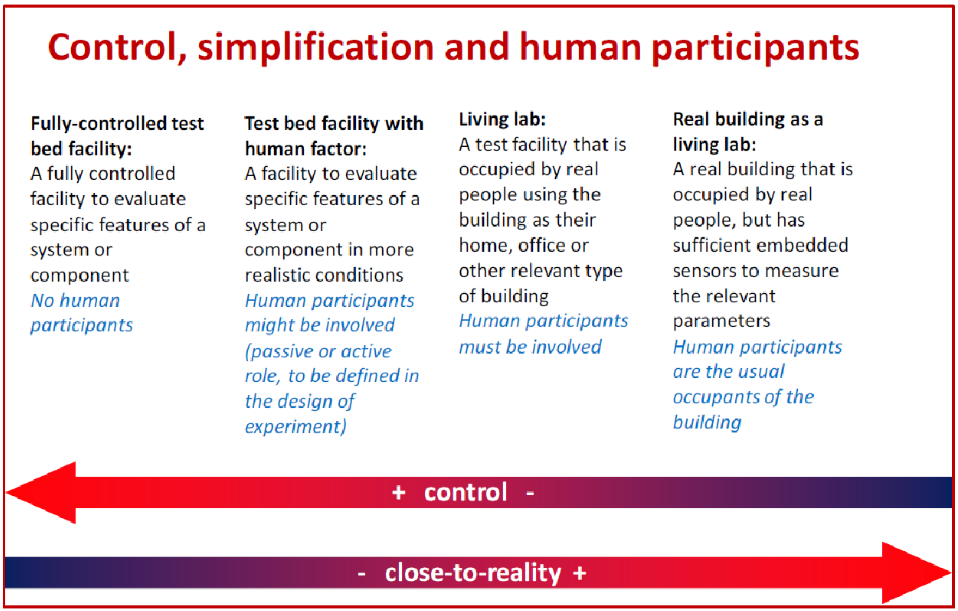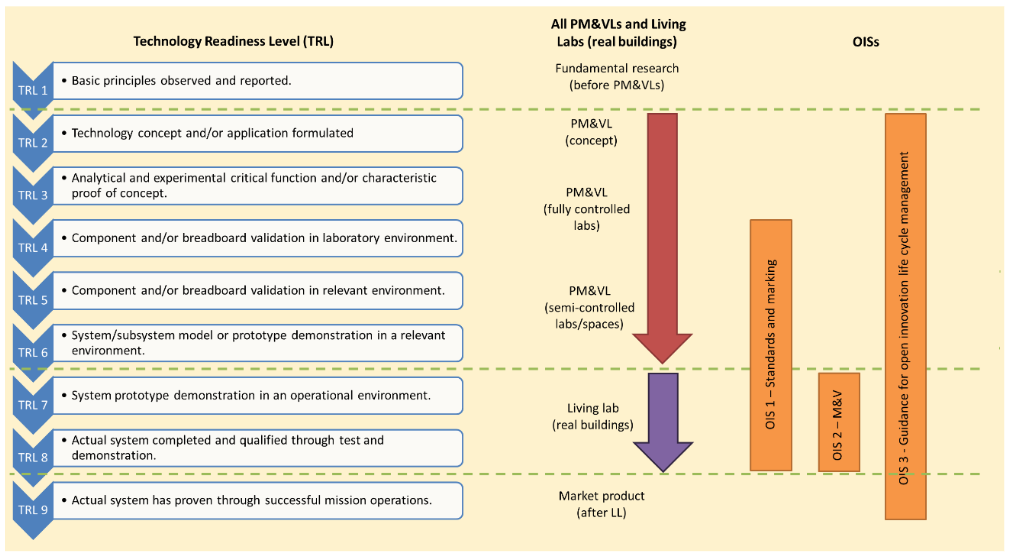PM&VL stands for pilot measurement and verification line. A PM&VL is a comprehensive test-chain aimed at supporting SMEs in the development and testing of building envelope technologies, and it focuses either on one specific type of technology (e.g. transparent components) or performance (e.g. impact on the envelope on the indoor environment). A PM&VL comprises a series of laboratories and additional capabilities such as simulation support.
OIS stands for open innovation service. In general, an OIS is service that supports companies such as SMEs in a certain innovation aspect such as certification of innovative products, in-situ performance evaluation, and use of open innovation. Each OIS may comprise one or more sub-services that can be used independently according to the companies’ needs. As opposed to PM&VLs, OISs do not focus on specific technologies or technical performances but have a more transversal mission.
A real building used as living lab is a building in normal operation occupied by real people but equipped with sufficient embedded sensors to measure relevant parameters. Human participants are the usual users of the chosen buildings and are invited to provide feedback by means of questionnaires. Real-building living labs enable to evaluate technologies and solutions in operational environments going therefore beyond PM&VLs capabilities in terms of achievable TRL.

Technology readiness levels (TRLs) are a method for estimating the maturity of technologies. TRLs enable consistent and uniform discussions of technical maturity across different types of technology. TRLs go from basic principles (TRL1) to system proven in operation environment (TRL9). For more details: TRLs description.
PM&VLs can support the development of a certain technology from the initial concept (TRL2) to demonstration in relevant environments (TRL6), while the final higher TRLs can be achieved by means of the real-building living labs that represent an operational environment. OISs can support the innovation and development process at different TRLs depending on the OIS.

While in closed innovation the entire innovation happens within a company (from the first idea to the development and to the exploitation of a product), open innovation is based on the concept that part of the innovation process happens outside of the company. In this context, “open” does not mean freely available to everyone, but simply that part of the innovation process is open. In open innovation, intellectual property (IP) is guaranteed by specific agreements.
Open innovation principles:
-
Connect with talented people outside the company;
-
Internal R&D used to create absorptive capacity;
-
No need to generate all new ideas internally: make the right connections;
-
Better business models provide higher return than focusing only on first-mover advantage;
-
Good ideas may come from any part of the company (not only R&D)
-
Master IP management: profit from external use, and buy-in strategy.
Closed innovation principles:
-
“Smart people all work for us”;
-
To profit from R&D, firms must invent, develop and sell by themselves;
-
If R&D has a new idea, they will be the first in the market;
-
Bringing something to the market before competitors provide the best return of investment in innovation;
-
Firms with better and more ideas win;
-
Internal control over IP and prevent competitors from profiting from it.
MEZeroE aims to create an EU distributed open innovation ecosystem for:
-
developing nearly Zero Energy Building (nZEB) Enabler Envelope Solutions;
-
transferring knowledge;
-
matching testing needs with test facilities;
-
providing monitoring in real buildings used as living labs;
-
standardizing cutting-edge solutions coming from SMEs and larger industries.
A single entry point (SEP) web-based multi-side virtual marketplace which will include:
-
9 Pilot Measurement & Verification Lines (PM&VL)
-
3 Open Innovation Services (OIS)
-
Additional resources and support including training, business model development, systematic IP and knowledge management, and more
MEZeroE will fast-track prototypes to the market as fully characterized and exploited (full potential unlocked) products.
The overall challenge that MEZeroE aims to address is the creation of an Open Innovation Test Bed for Building Envelope Components for high energy-efficient, healthy and comfortable buildings (nZEB).
OITB stands for open innovation test bed. OITBs are EU-funded projects managed by European Health and Digital Executive Agency (HaDEA), providing access to the physical facilities and services required for the development, testing and upscaling of nanotechnology and advanced materials.
MEZeroE OITB focuses on nearly Zero Energy Building (nZEB) Enabler Envelope Solutions.
